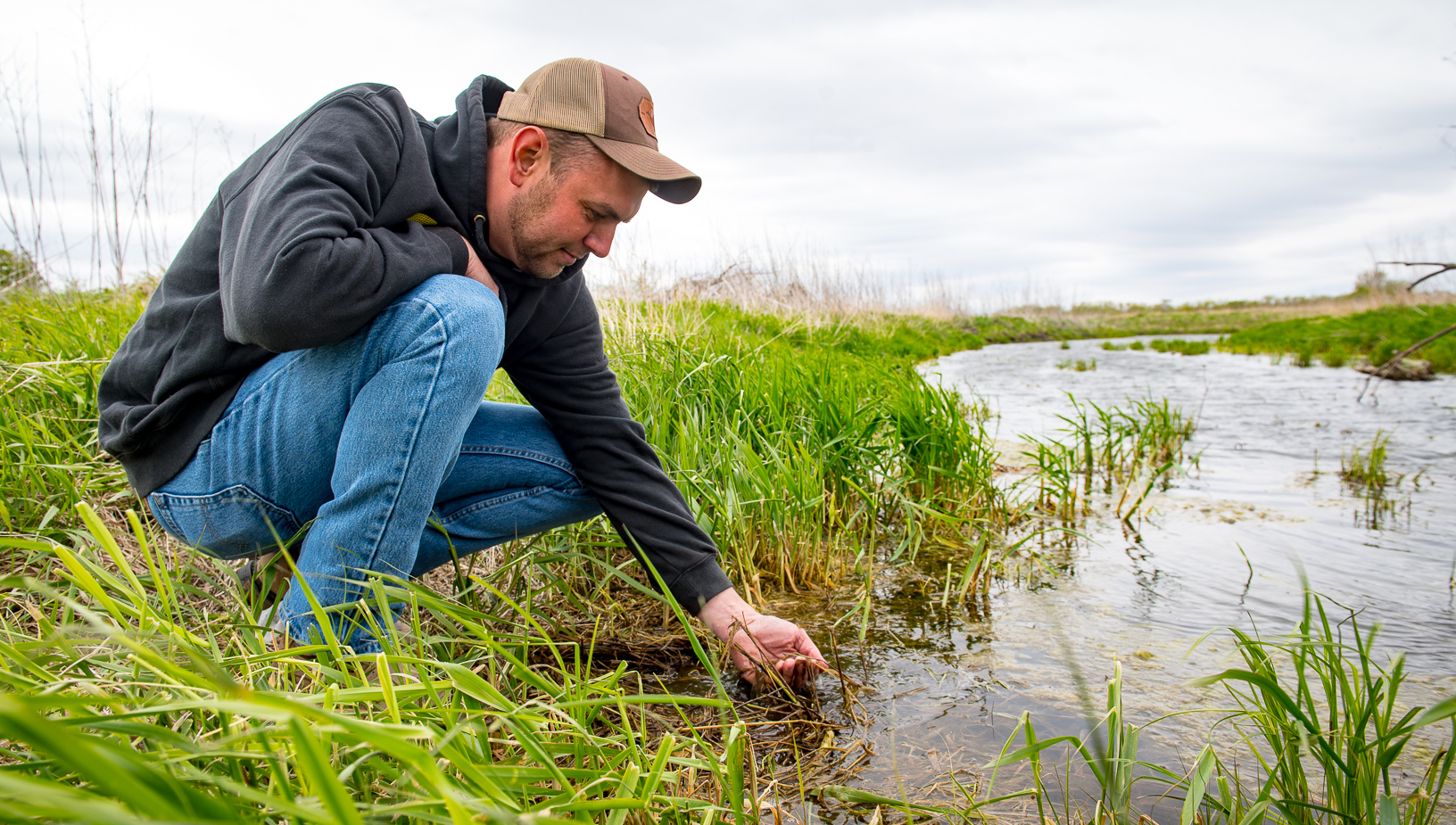
Tom Mrazek has been working with the ISA and Nature Conservancy to restore four oxbows. (Joseph L. Murphy/Iowa Soybean Association)
Farm the best, conserve the rest
June 3, 2020
This article is part one of a three-part series by Darcy Maulsby, an ISA Communications contributor.
Farmers, ag industry partners protect endangered species, water quality
Could saving a minnow help solve Iowa’s water quality challenges? Can farmers grow more productive crops by creating more habitat for a native bumble bee?
These tiny creatures might just provide some of the big answers to help address several pressing issues facing Iowa agriculture today. They are also listed as endangered by the U.S. Fish & Wildlife Service (USFWS).
That’s why the Iowa Soybean Association (ISA) is partnering with Syngenta, the U.S. Fish and Wildlife Service, The Nature Conservancy, Iowa State University and other organizations to help Iowa farmers create more habitat for the once-abundant Topeka shiner minnow and rusty-patched bumble bee.
“We’ve made a commitment to help bring these endangered species back,” says Roger Wolf, director of innovation and integrated solutions for ISA. “We’re not selling anything other than progress.”
“I don’t think the average person realizes how much farmers do to support conservation,” says Caydee Savinelli, stewardship team and pollinator lead at Syngenta. “Protecting natural resources is their heritage, their livelihood and their future.”
Working together helps farmers leverage technical expertise and funding sources to get more conservation on the ground.
“Partnerships are everything,” Kenney says. “Each one of us brings a different piece of the puzzle.”
When fish and pollinator habitats are restored, Iowans benefit from improved water quality and more opportunities for fishing, hunting, hiking, bicycling, bird watching and more.
“What you protect comes down to your values,” says Darrick Weissenfluh, a private lands biologist with the U.S. Fish and Wildlife Service who works with ISA on oxbow restorations. “The farmers I interact with care about their land and want to improve the natural resources on that land to leave a legacy for future generations.”
As word of ISA’s successful conservation partnerships spreads, new opportunities are created for farmers and groups that want to work with them.
“ISA and our partners share common goals focused on conservation and sustainability in farming,” Wolf says. “Our knowledge of how to implement conservation practices effectively in Iowa grows every year, thanks to the partnerships we’ve created.”
It’s an exciting time to be involved in agriculture, Weissenfluh adds.
“You have a unique opportunity to be part of the solution for restoring endangered species. I think that’s amazing.”
For more information or to discuss habitat restoration opportunities and suitability, contact ISA Conservationist Corey McKinney at cmckinney@iasoybeans.com or 515-334-1077.
This appeals to Tom Mrazek, who raises corn and soybeans east of Renwick in north-central Iowa. Since 2018, his family has been working with ISA and The Nature Conservancy to restore four oxbows. These small wetlands along Otter Creek in the Boone River watershed provide essential habitat for Topeka shiners.
“My dad and I are interested in conservation and wildlife preservation,” says Mrazek, who began farming after he earned his ag business degree from Iowa State University in 2011. “It has been great to see more fish using the oxbows, plus wood ducks and geese are nesting around there.”
Score a victory for water quality
As useful as restored oxbows are for promoting Topeka shiner habitat and species diversity, they’re also an approved practice for the Iowa Nutrient Reduction Strategy, a science-based framework to reduce nutrient loads in Iowa waters and the Gulf of Mexico.
Recent studies show a 45% reduction in nitrate export of water entering oxbows from subsurface drainage tiles, compared with water discharged directly to the adjacent stream, says Dr. Clay Pierce, an assistant professor in the Department of Natural Resource Ecology and Management at Iowa State University.
“Oxbow restorations are effective and relatively inexpensive,” he notes. “They also remove little or no land from agricultural production and last for decades.”
Restored oxbows create a ripple effect beyond the Topeka shiner that extends to people. “Topeka shiners are an indicator species,” says Aleshia Kenney, a fish and wildlife biologist with the USFWS who partners with ISA on oxbow restorations.
These minnows can handle much lower water quality parameters, including higher nitrate levels, than many other fish species. If Topeka shiner numbers are low in an area, there's a good chance that many other species could also be decreasing, Kenney explains.
“Improving habitat for the Topeka shiner improves water quality, which benefits many other living creatures, including people.”
Tapping the power of partnerships
The Topeka shiner isn’t the only species needing restored habitat in Iowa. So does the rusty-patched bumble bee.
This native pollinator was among the most common bumble bees in the Midwest in years past. Today, rusty-patched bumble bees are found consistently in only a few locations, mostly adjacent urban areas. In Iowa, they tend to be found on the eastern side of the state near Iowa City.
Like Topeka shiners, rusty-patched bumble bees are a canary-in-the-coal-mine type of species. Their loss can indicate that something else is going awry in the ecosystem. Syngenta, which created Operation Pollinator more than 20 years ago to help restore pollinators in agricultural landscapes, supports ISA, farmers and other industry partners who are seeding more habitat in Iowa.
Back